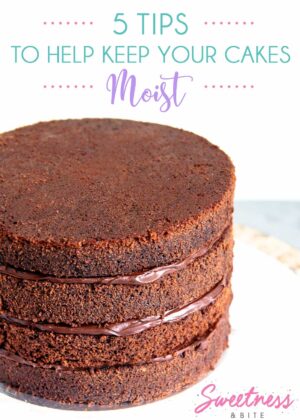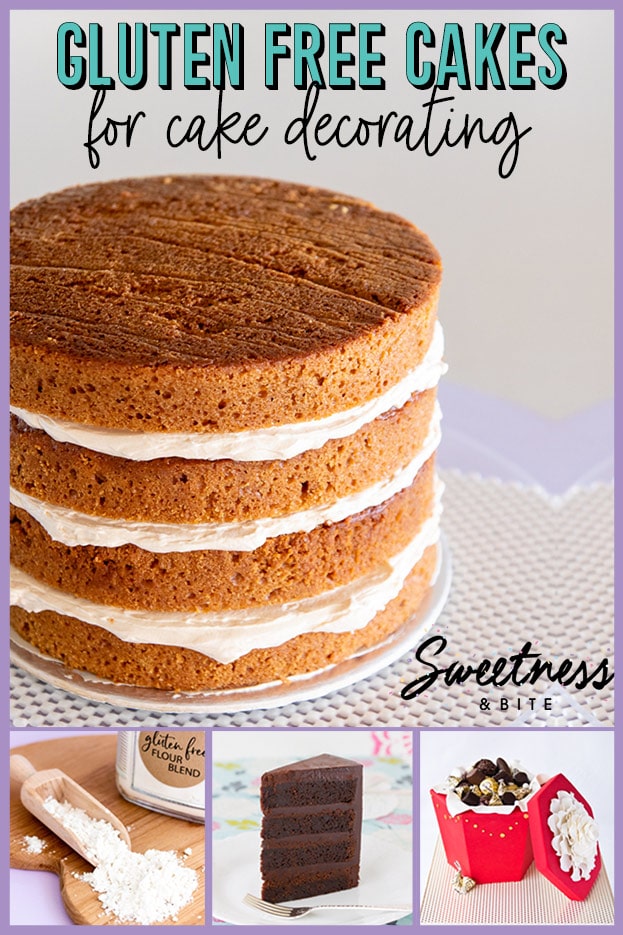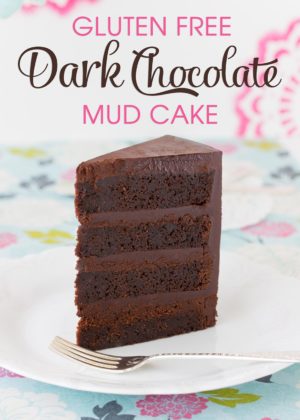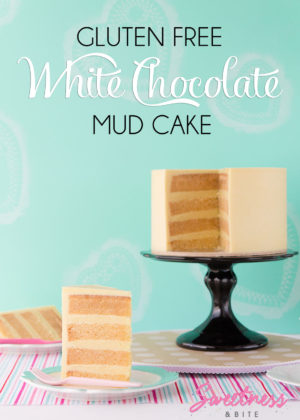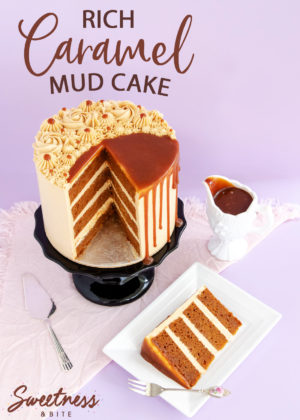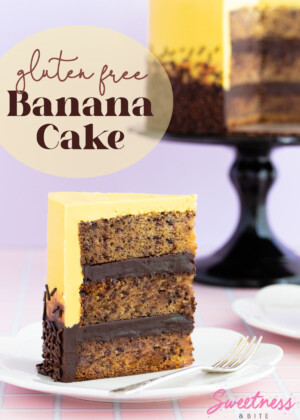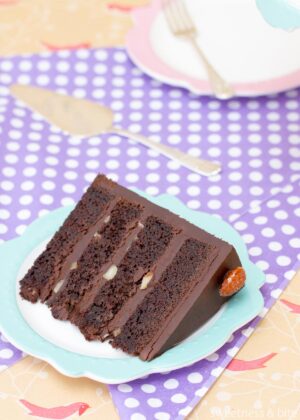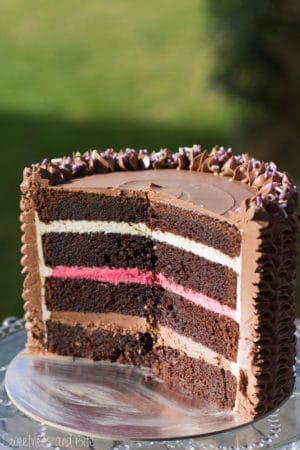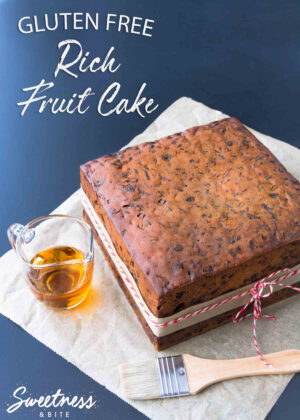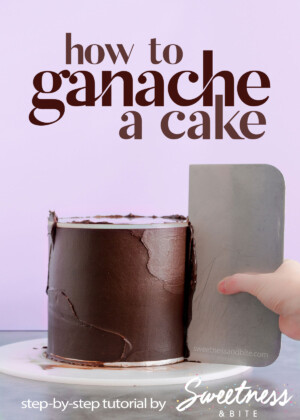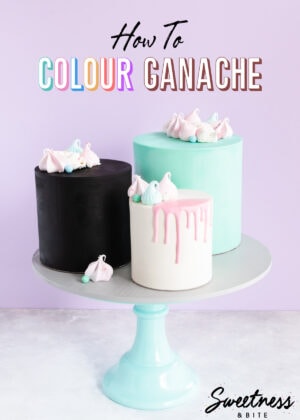Gluten Free Cakes for Decorating
This post may contain affiliate links to products I recommend. I receive a small commission at no cost to you if you make a purchase using my link.
Learn how to make the best gluten-free cakes, how to make them safely and what to consider when baking a cake for someone with Coeliac disease, plus gluten-free cake recipes that are perfect for cake decorating.
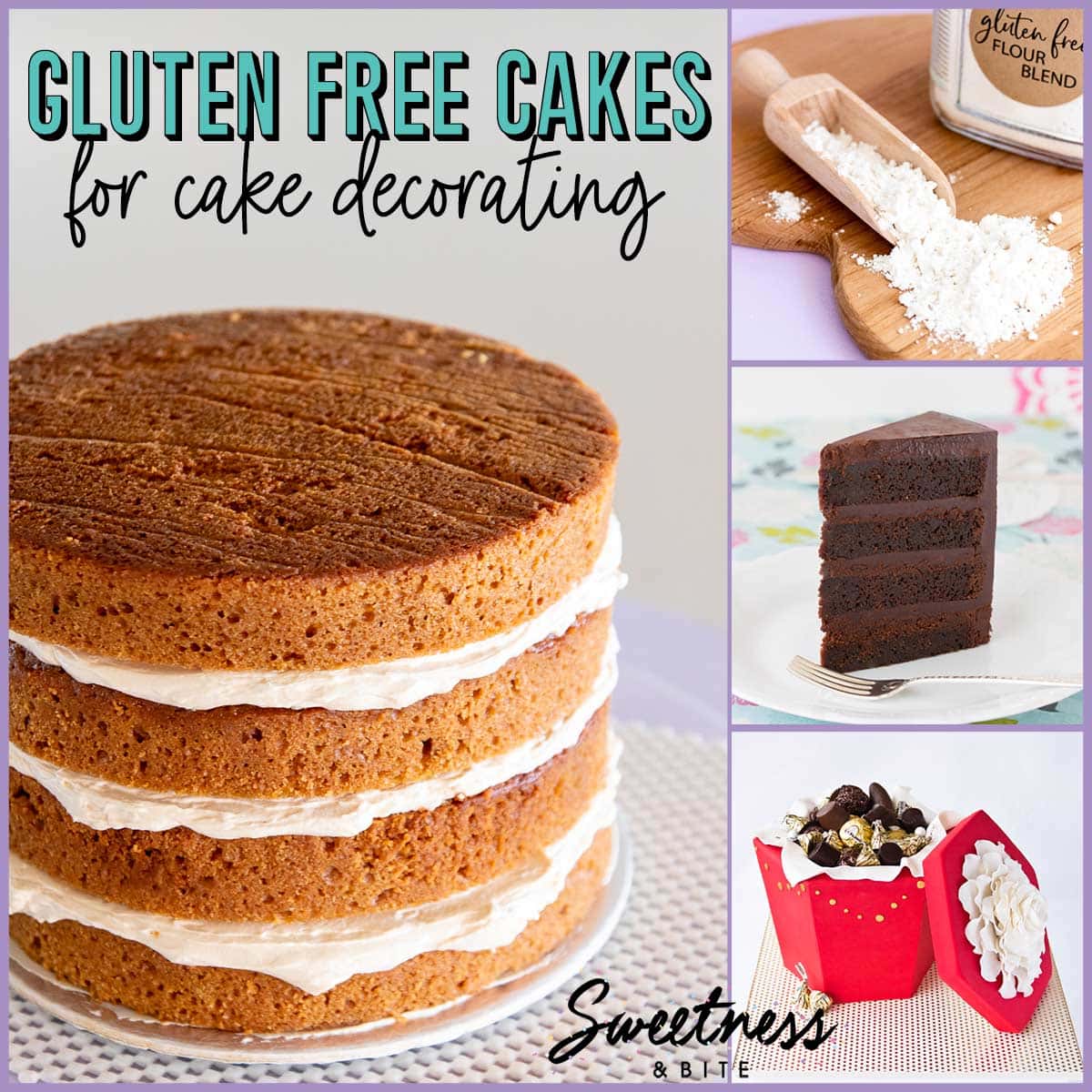
I’ve been a member of a lot of different cake decorating groups over the past 10+ years, and a question I see asked frequently is “I’ve been asked to make a gluten-free cake, does anyone have a good recipe?”.
Here’s the thing, there are a lot of great gluten free cake recipes out there, but there is a lot more to baking gluten free cakes (or gluten free anything, really) than just finding a good recipe.
People seem to fall into two camps, either they think baking a gluten-free cake is super difficult and the idea of it absolutely terrifies them, or they think it’s no big deal and that it’s as easy as swapping wheat flour for gluten-free flour.
I’m here to tell you that neither of those viewpoints is right – actually baking a gluten-free cake is not difficult, with the right recipe and ingredients. But it’s also not as simple as just swapping out one flour for another. There are many more things you need to take into account before you agree to make a gluten-free cake, especially if you don’t have a gluten-free kitchen and aren’t familiar with gluten-free baking in general.
But, we can meet somewhere in the middle and make amazing gluten-free cakes safely, with straightforward recipes and I have a big bowlful of helpful tips and tricks that will help you along the way, plus my own tried and tested gluten free cake recipes that work exceptionally well for decorating.
I want to start by quickly dispelling the two main myths that seem to be floating around about gluten-free cakes when it comes to cake decorating.
Myth #1 “Gluten free cakes are too soft to decorate with fondant, or to use as part of a tiered cake.”
This sure ain’t true! With the right recipe, they can be decorated in almost as many ways as other cakes, and if the cake is dowelled properly, it can be used for a tiered cake like almost any other recipe (the dowels do the work, not the cake!)
Myth #2 “Just swap the flour in any cake recipe for gluten-free flour – that’s all you need to do.”
Also, not true, as I touched on briefly above. While some recipes work well with a straight substitution of flours, there is much more to baking a gluten-free cake than just the recipe and the flour. There are important safety concerns that must be addressed before you even turn on the oven.
In this post I will talk you through what you need to take into consideration before agreeing to make a gluten-free cake, how to bake safely gluten-free, tips for actually baking gluten-free cakes, and a whole lot more. If you’re nervous, don’t panic, I will hold your hand (or not, if you find that creepy…) and we’ll get through it together.
Let’s get started, shall we?
Table of contents
Safely Baking Gluten Free
There are different “levels” of baking gluten-free or any allergen-free, and this is important to take into consideration before you start baking. (If you’re already a confident gluten-free baker then you probably already know a lot of this, but you might wish to give it a look anyway.)
If you are baking for someone who has a slight gluten sensitivity or has chosen to be gluten-free for any kind of lifestyle reason, then you can most likely just safely jump into making your gluten-free goodies. The precautions I’ll outline below will be helpful to you, but they won’t all necessarily be essential.
However, if you don’t have a 100% gluten free kitchen and have been asked to bake a cake for someone who has Coeliac Disease or has a gluten sensitivity that gives them a severe reaction to gluten, then there are some important things you will need to consider before you agree to make the cake.
Baking Cakes for People with Coeliac Disease
For people with Coeliac disease, consuming even *tiny* amounts of gluten can trigger symptoms. And even in those who don’t have severe symptoms, it still causes damage to the gut. This is why people with Coeliac disease must always have a completely gluten-free diet.
Here’s the thing about gluten – it can be found on almost any surface in any kitchen where gluten-containing products are used.
Crumbs go everywhere, and flour is so light that when you measure or sift it, some ends up in the air and it can then settle on any surface in the kitchen. So even if you are using gluten-free ingredients, if you’re baking in a non-gluten-free kitchen, there is always a chance of cross-contamination.
This is the most important thing I am going to say in this whole post – before you agree to make a gluten-free cake, check with that person (or if it’s a child, check with their caregivers). Find out if they have Coeliac disease or a gluten sensitivity. They will be able to tell you whether it is safe for you to bake for them in your kitchen.
I cannot overstate this enough. Unless your kitchen is completely gluten-free, you need to make sure the client/friend/family member is aware that there is a risk of cross-contamination.
I guarantee any Coeliac or gluten intolerant person would rather be asked a million questions about what they can and can’t eat than be made sick. And if at the end you can give them a delicious cake that’s safe for them to eat, then I reckon they’ll be twice as chuffed.
If you are at all uncomfortable or uncertain about being able to bake them a safe cake, it’s best to suggest they try to find a gluten-free baker to make their cake.
If they give you the go-ahead, then here are some important precautions that you should take:
Cleaning Your Kitchen
Clean everything. Wipe down the bench with cleaner and paper towels or a clean cloth, and then wipe it down a second time.
Make sure that any bowls and utensils (especially things like sieves) that you’re going to use have been well washed, in a dishwasher, if possible. Ideally, you would have entirely separate utensils that are used for gluten-free baking only, and that are stored in a separate area, but if not, then make sure they’re thoroughly cleaned.
Check the corners of your cake tins (especially square ones!) to make sure there isn’t any old cake crusted in there. Round cake tins tend to be safer than square, as they don’t have tight corners where the cake batter can get stuck.
Wipe down appliances like electric mixers, and check to make sure there isn’t wheat flour or old cake batter lurking in the motor vents which will blow into your cake batter.
Use a clean apron, hand towel and tea towel. And wash your hands (which I’m hoping you’re doing anyway!).
If you’re baking items with gluten the same day that you’re baking gluten free – it’s best to do the cleaning, bake the gluten free items, cool and store them, and then bake the gluten-y items.
Check Your Ingredients
You need to check the ingredient list of all of the packaged foods and ingredients that you plan to use, even things you use regularly and are reasonably sure don’t contain gluten. Gluten is sneaky, it hides in ingredients you would never think of, and it can go by as many aliases as a secret agent.
In most countries, it’s a legal requirement for manufacturers to list common allergens in bold in the ingredients list, or separately at the bottom, but it pays to scan the whole list anyway to double-check.
Here are some danger words to look out for:
Barley
Malt (malt extract, malt flavouring, malt syrup, malted milk)
Rye
Wheat Starch
Modified Wheat Starch
Cereal (some cereals are ok, if made from rice or corn, but if it just says ‘cereal’ and doesn’t specify – avoid)
Semolina
Spelt
Graham Flour
Oats and Oat Flour (oats themselves don’t contain gluten, however, they do contain a protein called avenin, which can cause reactions in some Coeliacs so are generally considered to not be gluten-free.)
One ingredient that particularly needs checking is icing sugar (aka powdered sugar or confectioner’s sugar) as some brands contain wheaten corn starch to stop the sugar from clumping. Choose pure icing sugar, or icing sugar with regular cornstarch instead (many brands will state on the packaging if they’re gluten-free).
Check non-stick baking pan sprays, sometimes these include wheat flour to stop things from sticking, choose one that is 100% oil instead (or just rub your baking pans with butter before lining with baking paper).
If you’re using fondant to decorate the cake, make sure you use one that is gluten-free.
Now here’s one that seems like it should be gluten-y but in fact, isn’t – ‘glucose syrup from wheat’. This is commonly used in confectionery and fondant icings, and while it is made from wheat it is so highly processed that no detectable gluten remains. So therefore it is safe for coeliacs.
If you see an ingredient that you’re not sure is or isn’t gluten-free – Google it! (What did we even do before the internet and Google?!) This list from Celiac.com is also an excellent resource of gluten-containing foods.
If there’s anything you’re not sure about, a quick search of the brand’s product page on their website will usually give you the information you need.
If in doubt, check with the person the cake is for. They’ll be able to tell you their favourite brands of products that are safe for them.
These things become second nature after a while, especially if it’s someone in your household who needs to be gluten-free.
As I mentioned above, if your whole household is gluten-free, then you shouldn’t need all the cleaning precautions, but you’ll still be checking your ingredients.
The most important thing to remember is that if you can mitigate all the risks and make the food safe, then do it. If you can’t do those things, you’re not confident that you can, or the person you’re baking for isn’t confident that you can, then give it a miss, and maybe pick up something from the supermarket instead.
For more information on Coeliac disease, please start by visiting the Coeliac New Zealand website or the website for Coeliacs in your own country.
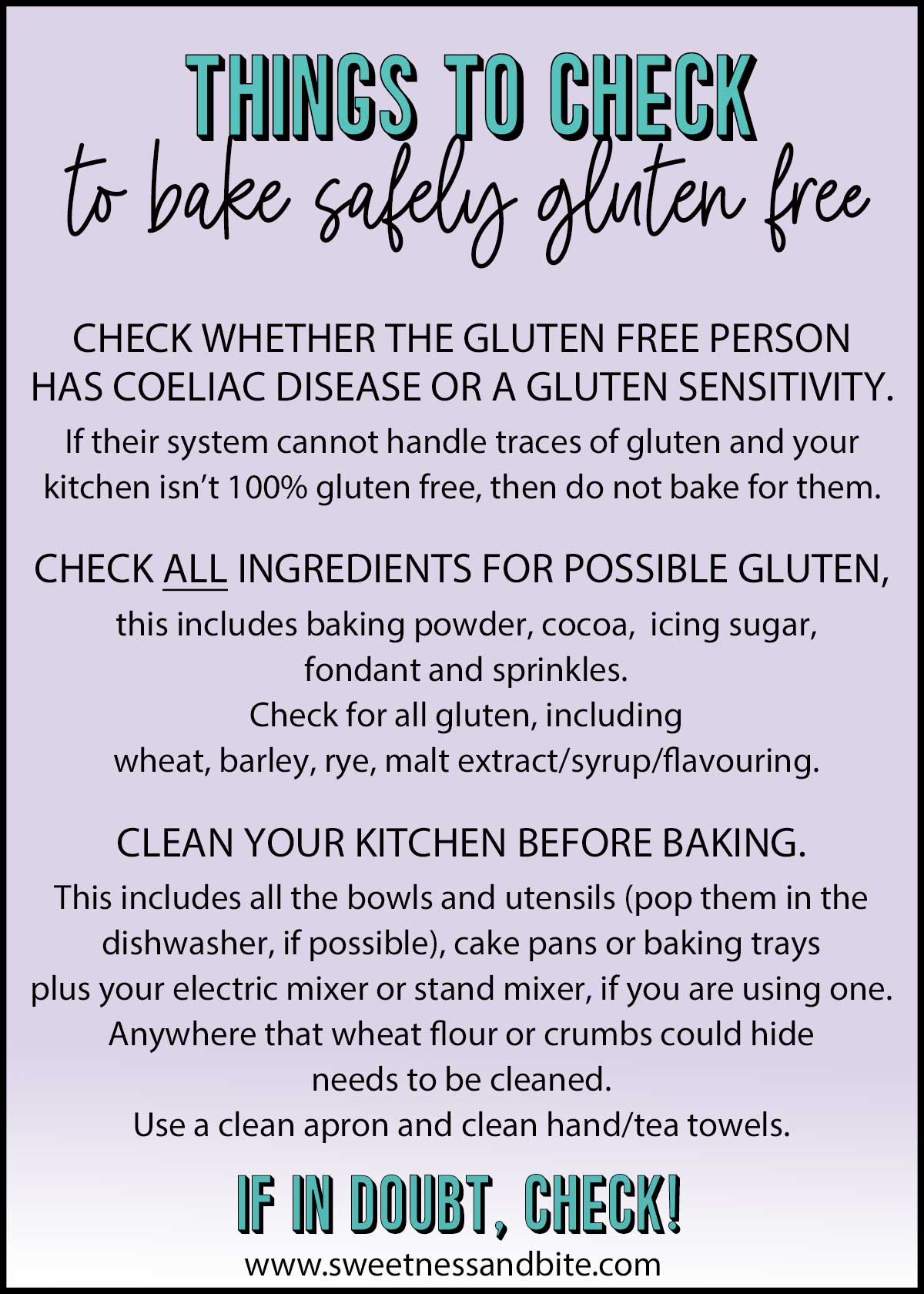
Gluten Free Flour
I’m not going to go fully into the science of gluten-free baking here, but if you’re new to GF baking, you need to know that there is no single gluten-free equivalent to wheat flour. To get a good result, gluten-free baking generally requires a combination of starches and flours.
You have two options. You can buy a pre-made gluten-free flour blend, or you can mix your own blend.
Because I develop gluten-free baking recipes and use a lot of flour, I like to mix my own. I have a blend that works for me and that I get super consistent results with, so that’s what I use most often. The blend uses tapioca starch, potato starch and brown rice flour and if you’re interested in why I like it and want to know how to make it yourself, you can check out my gluten-free flour blend for baking post.
Realistically though, while I would love for everyone to use the blend I use so we can all get the same results, I know that not everyone wants to mix their own flour. If you’re only baking the occasional cake, you may not want to buy and keep several different component flours. That’s where pre-made flour blends come in.
Pre-made flour blends generally contain 2-4 component starches and flours and some form of binding gum or thickener.
With the blend I use, I like to add xanthan gum to each individual recipe as I like to control how much goes in. Xanthan gum is a binder that helps to hold everything together, as the gluten in wheat flour does in regular baking.
In my cake recipes, I state how much xanthan gum to add to the recipe if you’re using my flour blend. If you’re using a pre-made flour then you’ll need to check the ingredients, if it contains a gum or thickener in the ingredients, you can leave the xanthan gum out of the recipe.
If you’re not familiar with gluten free baking, and whether you’re making one of my cake recipes or any other cake recipe, then I recommend trying out the recipe, with the flour you intend to use, before the cake is due.
This way you can make sure it works with the flours you are using, and you can troubleshoot the recipe if needs be. If you need help with troubleshooting my recipes, then feel free to leave a comment on the cake recipe page and I will do my very best to help you out.
Measurements
I know this may upset some people, but in my gluten free cake recipes I only give weight measurements for dry ingredients. I have a good reason for this though, cup measurements are not accurate for dry ingredients. They’re just not.
Not to mention that different countries use different sized cup measurements! In any kind of baking and even more so in gluten free baking it is far easier to troubleshoot a recipe if you know for sure that the ingredient amounts are correct.
If you don’t own a set of scales and I can’t convince you to buy some (pretty please, they’re not expensive!) then you can use this converter to get cup amounts for my recipes.
Cake Sizes
For each of my cake recipes, I give the tin size and the approximate height of the cake when it’s baked. Previously, I recommended an app called the Cake O Meter to scale recipes, but unfortunately, it’s not supported anymore and no longer available on the app store.
I have come across another cake scaling calculator that I intend to test out, and I will report back when I’ve done that.
Please be aware that this blog is a one-woman show, and a show run by someone who can’t afford to test every single recipe in every possible sized cake tin. This means that while they are great recipes and should work when scaled up. I cannot guarantee the recipe will work for every size.
Once again, I always suggest testing a recipe in the size you need before the event you’re making it for, so you can be sure it will work, with the flours you have, in the size you need.
Gluten Free Cake Baking Tips
Once the safety aspect and gluten-free flour stuff are out of the way, actually baking a gluten-free cake is pretty straightforward, with a good recipe.
As with any baking, make sure you read through the recipe before you start and check that you have everything you need.
One great benefit of baking gluten free is that you don’t have to worry so much about over-mixing your cake batter, as there is no gluten for us to overwork.
Most cakes can be baked in two cake pans for faster baking. For cakes 10” and up I would definitely suggest doing it this way. Remember though that once you level both cakes, you will end up with slightly less cake than you would if you bake it in one tin and only have to remove one crust, so consider scaling the recipe up to compensate.
If you don’t have two tins the same size or enough room in your oven for both tins at the same time, then I would suggest making two batches of batter rather than leaving the batter for the second cake sitting until the first cake bakes.
Most of my gluten-free cake recipes benefit from being left in the tin to cool completely (I bake the evening before I want to start icing it and leave the cake in the tin overnight). Just let the cake cool until it isn’t crazy hot anymore, and then cover the top of the cake with foil, securing it under the top lip of the tin.
Leaving the cakes to settle overnight makes it much easier to level and split the cake into layers.
For more gluten free baking tips, check out this post.
Decorating Gluten Free Cakes
If you’re covering the cakes in fondant, I highly suggest filling and covering the cakes in chocolate ganache before the fondant, especially if you’re doing any shaping/carving or making a tiered cake. Regular round or square cakes should be fine if filled with buttercream, but if stability is a concern then I would fill with buttercream but cover the outside in ganache.
If you’re not familiar with ganache, then I recommend you check out my How to Ganache a Cake post for everything you need to know.
All of the recipes I’ll be posting are suitable for the three-day decorating timeline that a lot of decorators use:
Day 1 – Bake
Day 2 – Ganache
Day 3 – Cover in fondant and decorate (and you can add in an extra day for decorating if you like your fondant to dry overnight before decorating).
If you’re worried about the cake drying out you can brush each layer with sugar syrup. I also have a post allll about using sugar syrup on cakes, including how to make it, how to use it, and how to flavour it to make your cakes taste even more amazing.
As I mentioned above, if you’re using fondant on your cake then check that it is gluten-free. The same goes for gum-paste or flower paste.
If you’re using icing/confectioner’s sugar to roll out your fondant, once again you will need to check that it’s pure icing sugar and does not contain wheaten cornstarch.
Chocolate for ganache is generally gluten-free, but check it anyway. Gluten is a sneaky bugger and will hide in the most unlikely of places.
Tips for Carving Gluten Free Cakes
Some gluten-free cakes are too delicate to carve, but many of the recipes I share below are perfect for making carved cakes, and with a good recipe and a few extra tips, you can carve almost any shaped cake.
The most important tip is to make sure you bake the cake the day before you want to carve it. All cakes are softer and more delicate the day they’re baked, and gluten-free cakes are no exception. Baking the cake the day/evening before will give the cake crumb time to settle and firm up.
Let the cake cool to room temperature in the cake tin, then you can either leave it in the tin and cover the top with foil, tucking the foil in around the rim of the tin, or carefully remove the cake from the tin, wrap in plastic wrap and pop it into an airtight container.
Another tip for carving cakes is to chill or freeze the cake before you carve it. Like making the cake the day before, this also firms up the cake crumb and makes it less, er, crumbly. Some people like to store their cakes in the fridge, which I don’t find necessary, but I do like to pop the cake into the fridge or freezer for an hour or two before carving it.
My third tip is one I mentioned above – to use ganache rather than buttercream for extra stability. Ganache gets a lot firmer than buttercream so it helps keep the shape of the cake. This is more important for 3D or tall carved cakes and those that you’ll be covering in fondant.
Right, let’s talk about some of my favourite gluten-free cake recipes!
Gluten-Free Cake Recipes for Decorating
Gluten Free Dark Chocolate Mud Cake
This dark chocolate mud cake is the most popular cake recipe here on S&B. And there’s a good reason for that – it’s easy to make, it’s super rich and chocolatey and it’s also firm and sturdy, so it can also be used for carved cakes.
Gluten Free White Chocolate Mud Cake
This is another popular recipe, for all the same reasons as the dark chocolate mud cake, but with a lighter white chocolate flavour.
Gluten Free Rich Caramel Mud Cake
This is one of my personal all-time favourite cakes. We start with making a real caramel sauce to use as the base for the cake, giving it a super rich caramel flavour. Like the other mud cake recipes, this one is also a great option if you need to carve a gluten-free cake.
Gluten Free banana Cake
This would be the cake I’d make if I was only allowed to make one kind of cake ever again. A rich, moist gluten free banana cake that keeps well and improves in flavour over time. This cake tastes amazing with your choice of buttercream or ganache (and fondant if you like!).
Gluten Free Toasted Almond Chocolate Cake
Another one of my favourites, this is a lighter-style chocolate cake, which uses toasted almond meal in the cake batter for a richer flavour. I also like to add chopped toasted almonds to the filling for extra crunch.
Gluten Free Devil’s Food Cake
This was the first cake I ever shared on this website (as evidenced by the terrible photos 😂) but it’s still our go-to family birthday cake recipe. It’s super versatile, is neither too light nor too heavy and works with an infinite number of filling flavours.
Gluten Free Rich Fruit Cake
Not just for Christmas cakes, this fruit cake is great for celebration cakes as well. It keeps exceptionally well, so can be decorated well ahead of time. If you’re a traditional fruit cake fan, you’re going to love this.
(**More recipes coming soon!**)
As always, if you have any questions or cake flavour requests, you can post a comment below and let me know.
If you’re a gluten-free baker and you think I should add something to this post, I would love to hear from you. I don’t claim to be a world expert on gluten-free baking, so I’m always open to new tips!
~Natalie
xx
You May Also Like…
